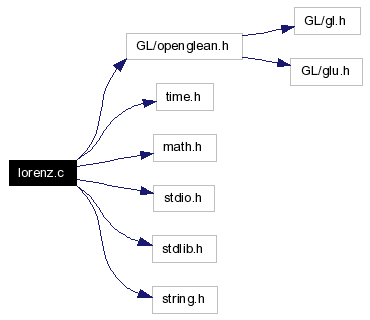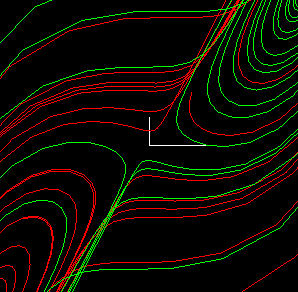

Include dependency graph for lorenz.c:

What it does:
This program starts with two particles right next to each other.
The particles move through a three-dimensional phase space governed by the following equations:

These are the Lorenz equations and define the "Lorenz Attractor". Any two particles arbitrarily close together will move apart as time increases, but their tracks are confined within a region of the space.
Commands:
Arrow keys : Rotate the viewPgUp, PgDn : Zoom in and outMouse click: Pick point on a particle trajectory'r'/'R' : Reset the simulation'm'/'M' : Modify the Lorenz parameters (in the text window)'s'/'S' : Stop (the advancement in time)'g'/'G' : Go<spacebar> : Single-step<Escape> : Quit

OpenGLEAN Lorenz Attractor Demonstration
Copyright 2004, 2005 the OpenGLEAN Project.<br/> Portions Copyright (C) 2004, the OpenGLUT project contributors.
OpenGLUT branched from freeglut in February, 2004.
#include <GL/openglean.h> #include <time.h> #include <math.h> #include <stdio.h> #include <stdlib.h> #include <string.h> #ifdef MSC_VER #include <crtdbg.h> /* DUMP MEMORY LEAKS */ #endif /******************* Defined Constants ***************************************/ /* Number of points to draw in the curves */ #define NUM_POINTS 512 /* Angle to rotate when the user presses an arrow key */ #define ROTATION_ANGLE 5.0 /* Amount to scale bu when the user presses PgUp or PgDn */ #define SCALE_FACTOR 0.8 /******************** Global Variables ***************************************/ /* Lorenz Attractor variables */ double s0 = 10, r0 = 28, b0 = 8 / 3.0; /* Default Lorenz parameters */ double time_step = .03; /* Time step in the simulation */ double sigma = 10, r = 28, b = 8 / 3.0; /* Lorenz attactor parameters */ double red_position [NUM_POINTS] [3]; /* Path of the red point */ double grn_position [NUM_POINTS] [3]; /* Path of the green point */ int array_index; /* Latest point in *_position */ double distance = 0; /* Distance between red/green */ /* GLUT variables */ /* double yaw = 0, pit = 0; */ /* Viewing rotation */ /* double scale = 1; */ /* Scale factor */ double xcen = 0, ycen = 0, zcen = 0; /* Coords of the examined point */ int animate = 1; /* 0:stop, 1:go, 2:single-step */ /************************ Functions ******************************************/ /* The Lorenz Attractor */ void calc_deriv (double position [3], double deriv [3]) { /* Calculate the Lorenz attractor derivatives */ deriv [0] = sigma * (position [1] - position [0]); deriv [1] = (r + position [2]) * position [0] - position [1]; deriv [2] = -position [0] * position [1] - b * position [2]; } void advance_in_time ( double time_step, double position [3], double new_position [3] ) { /* Move a point along the Lorenz attractor */ double deriv0 [3], deriv1 [3], deriv2 [3], deriv3 [3]; int i; /* Save the present values */ memcpy (new_position, position, 3 * sizeof (double)); /* First pass in a Fourth-Order Runge-Kutta integration method */ calc_deriv (position, deriv0); for (i = 0; i < 3; i++) new_position [i] = position [i] + .5 * time_step * deriv0 [i]; /* Second pass */ calc_deriv (new_position, deriv1); for (i = 0; i < 3; i++) new_position [i] = position [i] + .5 * time_step * deriv1 [i]; /* Third pass */ calc_deriv (position, deriv2); for (i = 0; i < 3; i++) new_position [i] = position [i] + time_step * deriv2 [i]; /* Second pass */ calc_deriv (new_position, deriv3); for (i = 0; i < 3; i++) new_position [i] = position [i] + (1/6.0) * time_step * (deriv0 [i] + 2.0 * (deriv1 [i] + deriv2 [i]) + deriv3 [i]); } /* GLUT callbacks */ #define INPUT_LINE_LENGTH 80 void key_cb (unsigned char key, int x, int y) { int i; char inputline [INPUT_LINE_LENGTH]; (void) x; /* XXX Reference at least once to placate GCC */ (void) y; switch (key) { case 'r': case 'R': /* Reset the simulation */ /* Reset the Lorenz parameters */ sigma = s0; b = b0; r = r0; /* Set an initial position */ red_position [0] [0] = rand () / (double) RAND_MAX; red_position [0] [1] = rand () / (double) RAND_MAX; red_position [0] [2] = rand () / (double) RAND_MAX; grn_position [0] [0] = rand () / (double) RAND_MAX; grn_position [0] [1] = rand () / (double) RAND_MAX; grn_position [0] [2] = rand () / (double) RAND_MAX; array_index = 0; /* Initialize the arrays */ for (i = 1; i < NUM_POINTS; i++) { memcpy (red_position [i], red_position [0], 3 * sizeof (double)); memcpy (grn_position [i], grn_position [0], 3 * sizeof (double)); } break; case 'm': case 'M': /* Modify the Lorenz parameters */ printf ( "Please enter new value for <sigma> (default %f, currently %f): ", s0, sigma ); fgets (inputline, INPUT_LINE_LENGTH - 1, stdin); sscanf (inputline, "%lf", &sigma); printf ( "Please enter new value for <b> (default %f, currently %f): ", b0, b ); fgets (inputline, INPUT_LINE_LENGTH - 1, stdin); sscanf (inputline, "%lf", &b); printf ( "Please enter new value for <r> (default %f, currently %f): ", r0, r ); fgets (inputline, INPUT_LINE_LENGTH - 1, stdin); sscanf (inputline, "%lf", &r); break; case 's': case 'S': /* Stop the animation */ animate = 0; break; case 'g': case 'G': /* Start the animation */ animate = 1; break; case ' ': /* Spacebar: Single step */ animate = 2; break; case 27: /* Escape key */ glutLeaveMainLoop (); break; } } void special_cb (int key, int x, int y) { (void) x; /* XXX Reference at least once to placate GCC */ (void) y; switch (key) { case GLUT_KEY_UP: /* Rotate up a little */ glRotated (ROTATION_ANGLE, 0, 1, 0); break; case GLUT_KEY_DOWN: /* Rotate down a little */ glRotated (-ROTATION_ANGLE, 0, 1, 0); break; case GLUT_KEY_LEFT: /* Rotate left a little */ glRotated (ROTATION_ANGLE, 0, 0, 1); break; case GLUT_KEY_RIGHT: /* Rotate right a little */ glRotated (-ROTATION_ANGLE, 0, 0, 1); break; case GLUT_KEY_PAGE_UP: /* Zoom in a little */ glScaled (1.0 / SCALE_FACTOR, 1.0 / SCALE_FACTOR, 1.0 / SCALE_FACTOR); break; case GLUT_KEY_PAGE_DOWN: /* Zoom out a little */ glScaled (SCALE_FACTOR, SCALE_FACTOR, SCALE_FACTOR); break; } glutPostRedisplay (); } void mouse_cb (int button, int updown, int x, int y) { double dist = 1e20; /* A very large number */ (void) x; /* XXX Reference at least once to placate GCC */ (void) y; (void) button; if (updown == GLUT_DOWN) dist = 0; /* so we don't get "unused variable" compiler warning */ /* * The idea here is that we pick the nearest point * to the mouse click position. Unfortunately I don't have the time to * implement it at the moment. * * XXX So, is that the nearest of the points in the ``trail''? * YYY (Yes, it is, John says.) */ } void draw_curve (int index, double position [NUM_POINTS] [3]) { int i = index; glBegin (GL_LINE_STRIP); do { i = (i == NUM_POINTS - 1) ? 0 : i + 1; glVertex3dv (position [i]); } while (i != index); glEnd (); } void display_cb (void) { char string [80]; glClear (GL_COLOR_BUFFER_BIT | GL_DEPTH_BUFFER_BIT); glColor3d (1.0, 1.0, 1.0); /* White */ /* Draw some axes */ glBegin (GL_LINES); glVertex3d (0.0, 0.0, 0.0); glVertex3d (2.0, 0.0, 0.0); glVertex3d (0.0, 0.0, 0.0); glVertex3d (0.0, 1.0, 0.0); glVertex3d (0.0, 0.0, 0.0); glVertex3d (0.0, 0.0, 1.0); glEnd (); glColor3d (1.0, 0.0, 0.0); /* Red */ draw_curve (array_index, red_position); glColor3d (0.0, 1.0, 0.0); /* Green */ draw_curve (array_index, grn_position); /* Print the distance between the two points */ glColor3d (1.0, 1.0, 1.0); /* White */ sprintf (string, "Distance: %10.6f", distance); glRasterPos2i (10, 10); glutBitmapString (GLUT_BITMAP_HELVETICA_12, (GLubyte *) string); glutSwapBuffers (); } void reshape_cb (int width, int height) { double ar; glViewport (0, 0, width, height); glMatrixMode (GL_PROJECTION); glLoadIdentity (); ar = width * 1.0 / height; if (ar > 1.0) glFrustum (-ar, ar, -1.0, 1.0, 10.0, 100.0); else glFrustum (-1.0, 1.0, -1 / ar, 1 / ar, 10.0, 100.0); glMatrixMode (GL_MODELVIEW); xcen = 0.0; ycen = 0.0; zcen = 0.0; glTranslated (xcen, ycen, zcen - 50.0); } void timer_cb (int value) { /* Function called at intervals to update the positions of the points */ double deltax, deltay, deltaz; int new_index = array_index + 1; /* Set the next timed callback */ glutTimerFunc (30, timer_cb, value); if (animate > 0) { if (new_index == NUM_POINTS) new_index = 0; advance_in_time ( time_step, red_position [array_index], red_position [new_index] ); advance_in_time ( time_step, grn_position [array_index], grn_position [new_index] ); array_index = new_index; deltax = red_position [new_index] [0] - grn_position [new_index] [0]; deltay = red_position [new_index] [1] - grn_position [new_index] [1]; deltaz = red_position [new_index] [2] - grn_position [new_index] [2]; distance = sqrt (deltax * deltax + deltay * deltay + deltaz * deltaz); if (animate == 2) animate = 0; } glutPostRedisplay (); } /* The Main Program */ int main (int argc, char *argv []) { int pargc = argc; /* Initialize the random number generator */ srand ((int) time (NULL)); /* Set up the OpenGL parameters */ glEnable (GL_DEPTH_TEST); glClearColor (0.0, 0.0, 0.0, 0.0); glClearDepth (1.0); /* Initialize GLUT */ glutInitWindowSize (600, 600); glutInit (&pargc, argv); glutInitDisplayMode (GLUT_RGB | GLUT_DOUBLE | GLUT_DEPTH); /* Create the window */ glutCreateWindow ("Lorenz Attractor"); glutKeyboardFunc (key_cb); glutMouseFunc (mouse_cb); glutSpecialFunc (special_cb); glutDisplayFunc (display_cb); glutReshapeFunc (reshape_cb); glutTimerFunc (30, timer_cb, 0); /* * Initialize the attractor: * The easiest way is to call the keyboard callback with an * argument of 'r' for Reset. */ key_cb ('r', 0, 0); /* Enter the GLUT main loop */ glutMainLoop (); #ifdef MSC_VER _CrtDumpMemoryLeaks (); /* DUMP MEMORY LEAK INFORMATION */ #endif return EXIT_SUCCESS; }
Supported in part by SourceForge.net.
Generated on Fri Sep 16 20:15:27 2005 for OpenGLEAN by
doxygen 1.4.3
The OpenGLEAN project is hosted by
olib.org and
SourceForge.